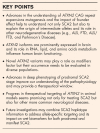Ataxin-2 gene: a powerful modulator of neurological disorders
- PMID: 34010218
- PMCID: PMC8279897
- DOI: 10.1097/WCO.0000000000000959
Ataxin-2 gene: a powerful modulator of neurological disorders
Abstract
Purpose of review: To provide an update on the role of Ataxin-2 gene (ATXN2) in health and neurological diseases.
Recent findings: There is a growing complexity emerging on the role of ATXN2 and its variants in association with SCA2 and several other neurological diseases. Polymorphisms and intermediate alleles in ATXN2 establish this gene as a powerful modulator of neurological diseases including lethal neurodegenerative conditions such as motor neuron disease, spinocerebellar ataxia 3 (SCA3), and peripheral nerve disease such as familial amyloidosis polyneuropathy. This role is in fact far wider than the previously described for polymorphism in the prion protein (PRNP) gene. Positive data from antisense oligo therapy in a murine model of SCA2 suggest that similar approaches may be feasible in humans SCA2 patients.
Summary: ATXN2 is one of the few genes where a single gene causes several diseases and/or modifies several and disparate neurological disorders. Hence, understanding mutagenesis, genetic variants, and biological functions will help managing SCA2, and several human diseases connected with dysfunctional pathways in the brain, innate immunity, autophagy, cellular, lipid, and RNA metabolism.
Copyright © 2021 The Author(s). Published by Wolters Kluwer Health, Inc.
Conflict of interest statement
Figures






Similar articles
-
Generation of an Atxn2-CAG100 knock-in mouse reveals N-acetylaspartate production deficit due to early Nat8l dysregulation.Neurobiol Dis. 2019 Dec;132:104559. doi: 10.1016/j.nbd.2019.104559. Epub 2019 Jul 31. Neurobiol Dis. 2019. PMID: 31376479
-
ATXN2-AS, a gene antisense to ATXN2, is associated with spinocerebellar ataxia type 2 and amyotrophic lateral sclerosis.Ann Neurol. 2016 Oct;80(4):600-15. doi: 10.1002/ana.24761. Ann Neurol. 2016. PMID: 27531668 Free PMC article.
-
ALS-associated genes in SCA2 mouse spinal cord transcriptomes.Hum Mol Genet. 2020 Jun 27;29(10):1658-1672. doi: 10.1093/hmg/ddaa072. Hum Mol Genet. 2020. PMID: 32307524 Free PMC article.
-
Spinocerebellar Ataxia Type 2.Adv Exp Med Biol. 2018;1049:175-195. doi: 10.1007/978-3-319-71779-1_8. Adv Exp Med Biol. 2018. PMID: 29427103 Review.
-
[Advance in research on spinocerebellar ataxia 2].Zhonghua Yi Xue Yi Chuan Xue Za Zhi. 2018 Apr 10;35(2):284-287. doi: 10.3760/cma.j.issn.1003-9406.2018.02.032. Zhonghua Yi Xue Yi Chuan Xue Za Zhi. 2018. PMID: 29653012 Review. Chinese.
Cited by
-
Genetic basis of cardiovascular aging is at the core of human longevity.J Cardiovasc Aging. 2022;2(2):25. doi: 10.20517/jca.2022.06. Epub 2022 Apr 14. J Cardiovasc Aging. 2022. PMID: 35531366 Free PMC article.
-
Insights from analyses of low complexity regions with canonical methods for protein sequence comparison.Brief Bioinform. 2022 Sep 20;23(5):bbac299. doi: 10.1093/bib/bbac299. Brief Bioinform. 2022. PMID: 35914952 Free PMC article.
-
Antisense oligonucleotides targeting basal forebrain ATXN2 enhances spatial memory and ameliorates sleep deprivation-induced fear memory impairment in mice.Brain Behav. 2023 Jun;13(6):e3013. doi: 10.1002/brb3.3013. Epub 2023 Apr 18. Brain Behav. 2023. PMID: 37072935 Free PMC article.
-
Ataxin-2: a powerful RNA-binding protein.Discov Oncol. 2024 Jul 22;15(1):298. doi: 10.1007/s12672-024-01158-y. Discov Oncol. 2024. PMID: 39039334 Free PMC article. Review.
-
The Fragile X Protein Family in Amyotrophic Lateral Sclerosis.Mol Neurobiol. 2023 Jul;60(7):3898-3910. doi: 10.1007/s12035-023-03330-x. Epub 2023 Mar 29. Mol Neurobiol. 2023. PMID: 36991279 Free PMC article. Review.
References
-
- Pulst SM, Nechiporuk A, Nechiporuk T, et al. . Moderate expansion of a normally biallelic trinucleotide repeat in spinocerebellar ataxia type 2. Nat Genet 1996; 14:269–276. - PubMed
-
- Imbert G, Saudou F, Yvert G, et al. . Cloning of the gene for spinocerebellar ataxia 2 reveals a locus with high sensitivity to expanded CAG/glutamine repeats. Nat Genet 1996; 14:285–291. - PubMed
-
- Sanpei K, Takano H, Igarashi S, et al. . Identification of the spinocerebellar ataxia type 2 gene using a direct identification of repeat expansion and cloning technique, DIRECT. Nat Genet 1996; 14:277–284. - PubMed
-
- Lastres-Becker I, Rüb U, Auburger G. Spinocerebellar ataxia 2 (SCA2). Cerebellum 2008; 7:115–124. - PubMed
-
- Choudhry S, Mukerji M, Srivastava AK, et al. . CAG repeat instability at SCA2 locus: anchoring CAA interruptions and linked single nucleotide polymorphisms. Hum Mol Genet 2001; 10:2437–2446. - PubMed
Publication types
MeSH terms
Substances
LinkOut - more resources
Full Text Sources
Other Literature Sources
Medical
Research Materials

